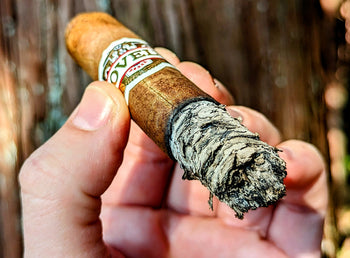Prior to transplanting tobacco seedlings, a farmer must determine whether or not their crop will be shaded for its entire life. This is a very crucial decision, as it has just as much to do with a tobacco strain's sensitivity to sunlight, as it does with texture, appearance, aroma, and taste.
And while a huge chunk of the cigar market is saturated with shade-grown wrappers, the contents of these stogies are almost always a sun-grown affair.
Shocked? Don't be.
Just because a tobacco plant is allowed to soak up whatever sunlight Mother Nature throws at it during a growing season, doesn't mean that there is going to be a massive spike in strength or flavor intensity.
Different leaves on a tobacco plant produce different strengths and flavor profiles once cured and fermented. So writing off all sun-grown cigars as "strong" is only going to make you look like a dithering dolt.
Don't be a dolt. Get your facts straight, and try some different smokes on for size. Regardless as to whether they may be sun or shade-grown. You and your palate might be surprised by what you discover...

Eternal Sunshine of the Fermented Kind
Extended exposure to direct sunlight will cause plants to either shrivel up and die, or toughen up and thrive. In the case of sun-grown cigar tobacco, this translates to flavors that are a little bit more on the robust side.
For certain tobacco strains, this can mean a wrapper leaf that isn't as silky smooth feeling or looking as its shade-grown sibling. An aesthetic side-effect of the toughening process of the leaf itself, as it simultaneously absorbs and protects itself from the intensity of the sun.
This is why sun-grown tobacco varietals are so ideal for making maduro cigar wrappers. Sure, they may be a little veiny and even rugged at times, but even non-maduro cigars excel when exposed to extended periods of aging and fermentation. Not only does this help remove naturally occurring impurities within the plant, but it also helps enhance flavor complexity and aromatics.
So think of sun-grown cigars and their maduro counterparts as a vintage red wine, or a prime bottle of aged whiskey on the shelf. Perfection takes time. So be patient, and when in doubt allow that cigar to age in your humidor for another year before giving that sun-grown a shot.
Some Sun-Grown Cigar Suggestions
Plasencia Cosecha 146 La Musica

Throwing Some Shade
Long before man ever considered smoking various forms of vegetation, tobacco plants were growing on their own, often deep within the forest. Thanks to the shaded canopy above, these strains of tobacco produced a far silkier, elastic leaf consistency than their sun-grown brethren once cured and fermented.
But taming a jungle just to grow a few plants is a pain in the patella. So man moved these tobacco strains out of the forest, and into the sun. But when the plants began to mottle and ruin, a remedy had to be concocted. The fix? Sheets of cloth on poles diffusing the direct sunlight, thus allowing a far easier form of harvesting and care to follow.
Before long, cheesecloth had replaced bed sheets, and by the time certain strains of tobacco made their way up to the Connecticut River Valley, a shade-grown cigar revolution was set to begin.
Today, semi-transparent nylon sheets have all but replaced the classic cheesecloth, and the cloud-heavy farmlands of Ecuador provide much of the world's shade-grown cigar wrapper leaf. Sure, Connecticut State shade-grown tobacco is still a thing, but it is but a shadow of its former self.
While some associate the Connecticut leaf's move down to Ecuador as one based upon a search for even smoother shade-grown smokes, others say it was due to lower labor costs and closer manufacturing facility accessibility.
Whatever the reason, we can't really blame cigar manufacturers for making the move from man-made shades to continuously cloudy skies. Why pay for additional materials and deal with the physical labor associated with setting up and maintaining massive canopies when nature can provide them for free?
Either way, shade-grown tobacco leaf continues to be just as mellow, silky, and appealing as ever, and when blended with the right sun-grown internal ingredients, makes for one mighty fine smoking experience.

